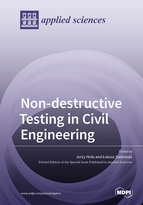Non-destructive Testing in Civil Engineering
A special issue of Applied Sciences (ISSN 2076-3417). This special issue belongs to the section "Civil Engineering".
Deadline for manuscript submissions: closed (30 November 2021) | Viewed by 46723
Special Issue Editors
Interests: construction; building materials; cement composites; brick walls; dampness; non-destructive testing methods; artificial intelligence
Interests: cementitious materials; sustainable development; artificial intelligence; nondestructive testing; surface morphology
Special Issues, Collections and Topics in MDPI journals
Special Issue Information
Dear Colleagues,
The progressive development of civil engineering involves the development of already known methods and the search for new techniques for testing materials, elements, structures, and entire buildings. In these activities, much attention is focused on non-destructive testing (NDT) methods, which, in principle, do not interfere with the structures being tested. However, they allow many important features and parameters to be assessed as well as imperfections, damage, or internal defects to be located. Such knowledge is needed in many situations, i.e., for structures and buildings for the correct assessment of the degree of degradation, safety of use, reliability, or durability. Significant progress has recently occurred in the development of the acoustic group of methods, where, as in medicine, the trend is obtaining information about examined structures and the interior of elements from acoustic signals processed by appropriate software using complex data analysis, including artificial intelligence.
This Special Issue aims to present to all those interested in the cognition and application of non-destructive testing, the latest achievements and experience regarding new research methods and their applications, the effects of the latest original scientific research, and the effects of utilitarian, laboratory, and field applications conducted in the area of civil engineering.
We invite you to send original articles on topics including but not limited to:
- new and improved non-destructive testing methods and techniques;
- complementary applications of research methods;
- original research methodologies;
- analysis of non-destructive test results, including the use of sophisticated mathematical algorithms and artificial intelligence;
- diagnostics of materials, elements, and structures, as well as entire buildings; and
- unusual case studies in the field of non-destructive testing in civil engineering.
Prof. Jerzy HołaProf. Łukasz Sadowski
Guest Editors
Manuscript Submission Information
Manuscripts should be submitted online at www.mdpi.com by registering and logging in to this website. Once you are registered, click here to go to the submission form. Manuscripts can be submitted until the deadline. All submissions that pass pre-check are peer-reviewed. Accepted papers will be published continuously in the journal (as soon as accepted) and will be listed together on the special issue website. Research articles, review articles as well as short communications are invited. For planned papers, a title and short abstract (about 100 words) can be sent to the Editorial Office for announcement on this website.
Submitted manuscripts should not have been published previously, nor be under consideration for publication elsewhere (except conference proceedings papers). All manuscripts are thoroughly refereed through a single-blind peer-review process. A guide for authors and other relevant information for submission of manuscripts is available on the Instructions for Authors page. Applied Sciences is an international peer-reviewed open access semimonthly journal published by MDPI.
Please visit the Instructions for Authors page before submitting a manuscript. The Article Processing Charge (APC) for publication in this open access journal is 2400 CHF (Swiss Francs). Submitted papers should be well formatted and use good English. Authors may use MDPI's English editing service prior to publication or during author revisions.
Keywords
- non-destructive testing
- civil engineering
- construction materials
- structures
- buildings







